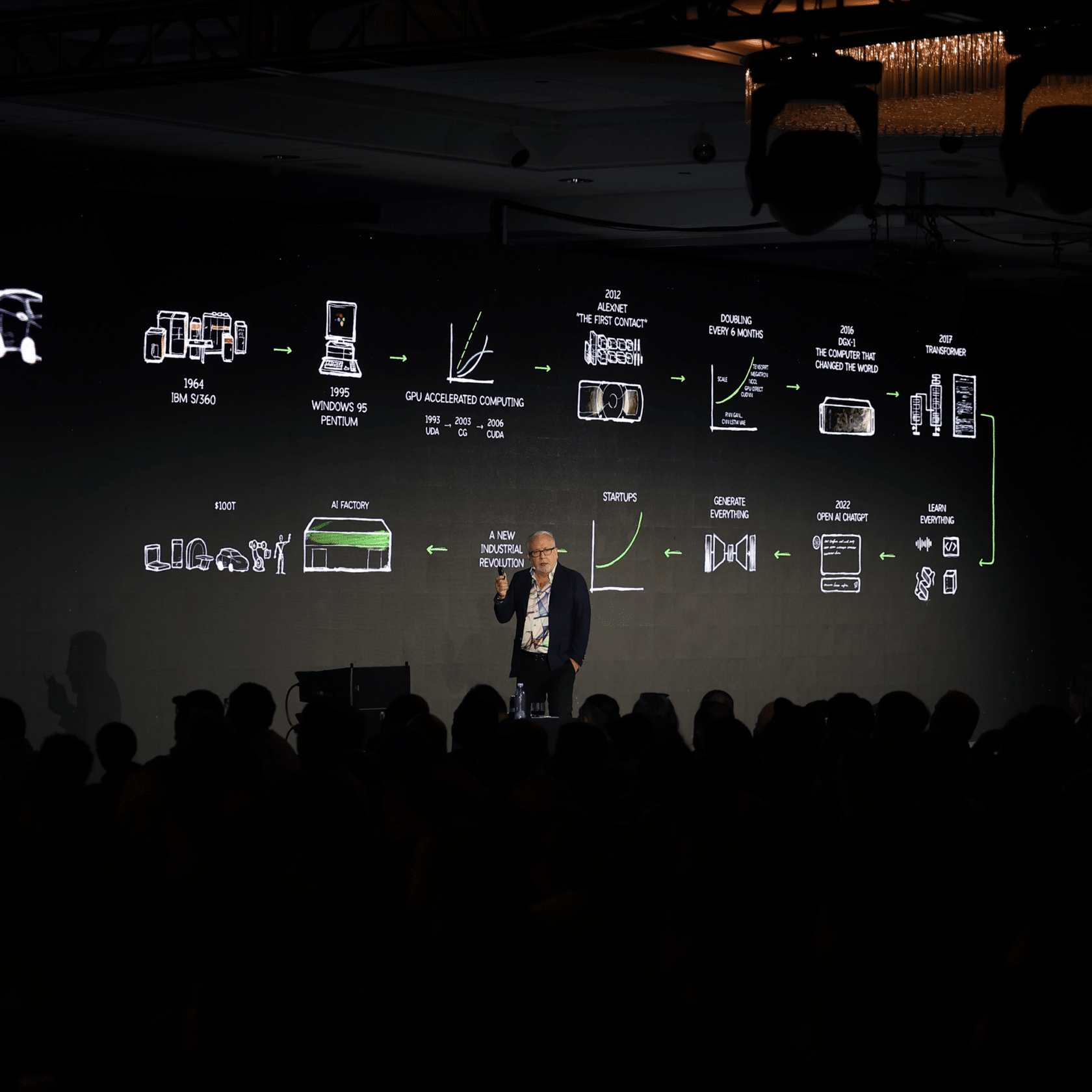Accelerated computing is sustainable computing, Bob Pette, NVIDIA’s vice president and general manager of enterprise platforms, explained in a keynote at the NVIDIA AI Summit on Tuesday in Washington, D.C.
NVIDIA’s accelerated computing isn’t just efficient. It’s critical to the next wave of industrial, scientific and healthcare transformations.
“We are in the dawn of a new industrial revolution,” Pette told an audience of policymakers, press, developers and entrepreneurs gathered for the event. “I’m just here to tell you that we’re designing our systems with not just performance in mind, but with energy efficiency in mind.”
NVIDIA’s Blackwell platform has achieved groundbreaking energy efficiency in AI computing, reducing energy consumption by up to 2,000x over the past decade for training models like GPT-4.
NVIDIA accelerated computing is cutting energy use for token generation — the output from AI models — by 100,000x, underscoring the value of accelerated computing for sustainability amid the rapid adoption of AI worldwide.
“These AI factories produce product. Those products are tokens, tokens are intelligence, and Intelligence is money,” Pette said. That’s what “will revolutionize every industry on this planet.”
 NVIDIA’s CUDA libraries, which have been fundamental in enabling breakthroughs across industries, now power over 4,000 accelerated applications, Pette explained.
NVIDIA’s CUDA libraries, which have been fundamental in enabling breakthroughs across industries, now power over 4,000 accelerated applications, Pette explained.
“CUDA enables acceleration…. It also turns out to be one of the most impressive ways to reduce energy consumption,” Pette said.
These libraries are central to the company’s energy-efficient AI innovations driving significant performance gains while minimizing power consumption.
Pette also detailed how NVIDIA’s AI software helps organizations deploy AI solutions quickly and efficiently, enabling businesses to innovate faster and solve complex problems across sectors.
Pette discussed the concept of agentic AI, which goes beyond traditional AI by enabling intelligent agents to perceive, reason and act autonomously.
Agentic AI is capable of ”reasoning, of learning, and taking action,” Pette said. It’s transforming industries like manufacturing, customer service, and healthcare,” Pette said.
These AI agents are transforming industries by automating complex tasks and accelerating innovation in sectors like manufacturing, customer service and healthcare, he explained.
He also described how AI agents empower businesses to drive innovation in healthcare, manufacturing, scientific research and climate modeling.
With agentic AI, “you can do in minutes what used to take days,” Pette said.
NVIDIA, in collaboration with its partners, is tackling some of the world’s greatest challenges, including improving diagnostics and healthcare delivery, advancing climate modeling efforts and even helping find signs of life beyond our planet.
NVIDIA is collaborating with SETI to conduct real-time AI searches for fast radio bursts from distant galaxies, helping continue the exploration of space, Pette said.
Pette emphasized that NVIDIA is unlocking a $10 trillion opportunity in healthcare.
Through AI, NVIDIA is accelerating innovations in diagnostics, drug discovery and medical imaging, helping transform patient care worldwide.
Solutions like the NVIDIA Clara medical imaging platform are revolutionizing diagnostics, Parabricks is enabling breakthroughs in genomics research and the MONAI AI framework is advancing medical imaging capabilities.
Pette highlighted partnerships with leading institutions, including Carnegie Mellon University and the University of Pittsburgh, fostering AI innovation and development.
Pette also described how NVIDIA’s collaboration with federal agencies illustrates the importance of public-private partnerships in advancing AI-driven solutions in healthcare, climate modeling and national security.
Pette also announced that a new NVIDIA NIM Agent Blueprint supports cybersecurity advancements, enabling industries to safeguard critical infrastructure with AI-driven solutions.
In cybersecurity, Pette highlighted the NVIDIA NIM Agent Blueprint, a powerful tool enabling organizations to safeguard critical infrastructure through real-time threat detection and analysis.
This blueprint reduces threat response times from days to seconds, representing a significant leap forward in protecting industries.
“Agentic systems can access tools and reason through full lines of thought to provide instant one-click assessments,” Pette said. “This boosts productivity by allowing security analysts to focus on the most critical tasks while AI handles the heavy lifting of analysis, delivering fast and actionable insights.
NVIDIA’s accelerated computing solutions are advancing climate research by enabling more accurate and faster climate modeling. This technology is helping scientists tackle some of the most urgent environmental challenges, from monitoring global temperatures to predicting natural disasters.
Pette described how the NVIDIA Earth 2 platform enables climate experts to import data from multiple sources, fusing them together for analysis using Nvidia Omniverse. “NVIDIA Earth 2 brings together the power of simulation AI and visualization to empower the climate, tech ecosystem,” Pette said.
NVIDIA’s Greg Estes on Building the AI Workforce of the Future
Following Pette’s keynote, Greg Estes, NVIDIA’s vice president of corporate marketing and developer programs, underscored the company’s dedication to workforce training through initiatives like the NVIDIA AI Tech Community.
And through its Deep Learning Institute, NVIDIA has already trained more than 600,000 people worldwide, equipping the next generation with the critical skills to navigate and lead in the AI-driven future.
SUBHEAD: Exploring AI’s Role in Cybersecurity and Sustainability
Throughout the week, industry leaders are exploring AI’s role in solving critical issues in fields like cybersecurity and sustainability.
Upcoming sessions will feature U.S. Secretary of Energy Jennifer Granholm, who will discuss how AI is advancing energy innovation and scientific discovery.
Other speakers will address AI’s role in climate monitoring and environmental management, further showcasing the technology’s ability to address global sustainability challenges.
Learn more about how this week’s AI Summit highlights how AI is shaping the future across industries and how NVIDIA’s solutions are laying the groundwork for continued innovation.
